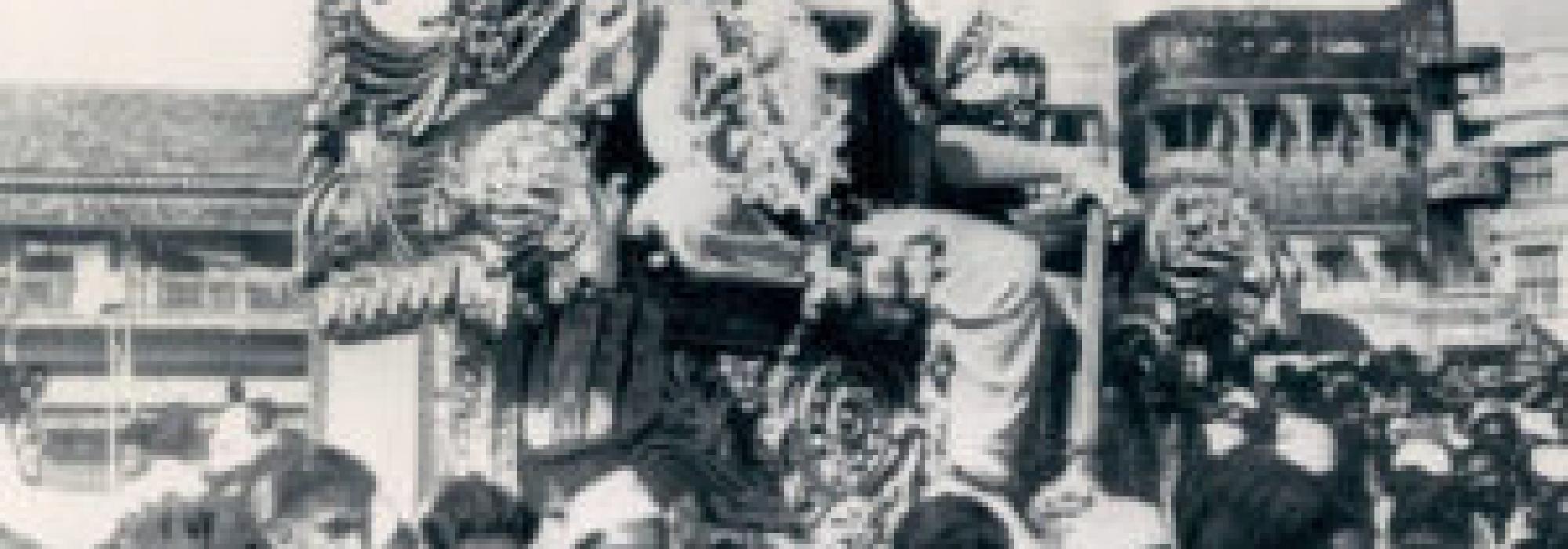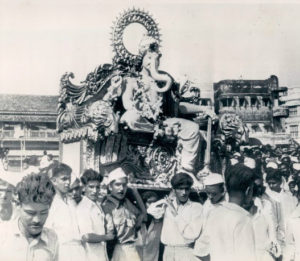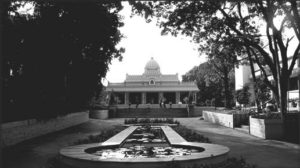Once my craze for English came under control, the craze for Kannada began. During those days [i.e. the early 20th century], for people of my age, a prominent name amongst living legends was Bal Gangadhar Tilak (1856–1920). “Tilak is singularly brave; everyone else falls short in comparison with him; Tilak is the only man-lion!” – these were our thoughts during that time. It appears those words were true. I was aware that Tilak started the public celebration of the Ganesha Festival in Pune, and through his inspiration it spread across Maharashtra, awakening the people and giving a voice to their feelings.
I asked myself, “Why shouldn’t we follow this in Karnataka as well?” and in response, I thought that we should appeal to the people of Karnataka. So I wrote a booklet. In that work—to the extent of my abilities—I had narrated the story of Ganesha, the secret principle behind his form, the deity’s folksy idealism, and so on. Who was to tell whether this write-up was good enough for publication? By that time, I was quite familiar with the name of Sri. S G Narasimhacharya. In school, I had read his writings, Dilīpa carite and Aja-nṛpa carite; I had studied two ‘Readers’ from Macmillan Publishers that he had edited; I had gone through a few issues of the Karnāṭaka Kāvya-mañjari that he co-edited. And so, his works of prose and poetry had established in me great admiration and respect towards him. I decided therefore that I should show him my write-up on Ganesha.
He lived in a house on the north side row of a road named Hospital Lane, which goes east from the Narasimha Swamy Temple in Upparpete (Balepete) and joins Doddapete next to the current Mysore Bank (the erstwhile Mental Hospital). When I visited him, his friend—and an important person—Sri. G G Narasimhacharya was also present. Inspired by the greatness of Swami Vivekananda, GG had become his disciple and had toured with the Swami for some time. He wasn’t in a high position; he must have been a clerk in the District Office. However, his knowledge of Vedānta and literature was vast and his patriotism, full of vigour. His frame was tall, serious, and pleasant. Let’s return to the subject of this GG another time.
S G Narasimhacharya was not a well-built person. Average-sized; we could say that he was rather thin. His physical build was not of a kind that would make an instant impression. When I told him about the reason for my visit, he said, “Can you read it? We’ll listen.” When I finished reading it, he took it and read it again himself. Then,
SG: You have used the word “ಆಧುನಿಕ” (ādhunika = modern). What does it mean?
Me: It means “ಈಚೀಚಿನ” (īcīcina = recent)
SG: In that case, why can’t you write it as “ಈಚೀಚಿನ” itself? I have a Maharashtrian friend who knows Sanskrit well. Once when he saw this word “ಆಧುನಿಕ,” he asked me what it meant. I was surprised. Isn’t it the adjective form of the Sanskrit word “ಅಧುನಾ” (adhunā)? When it is so difficult for someone who knows Sanskrit, how will the common people who don’t know Sanskrit understand this word?
I deserved this slap, which I gladly accepted and got over. I have got such slaps quite a few times.
Our association that began thus matured in a few days. During those years, S G Narasimhacharya and G G Narasimhacharya visited the Ramakrishna Math, in the first road of Chamarajpet, at least two or three times a week. There I had the privilege of listening to SG. The topics included literary attributes, stories of poets, history, philosophy of religions, social purification, and so forth.
He liked simplicity of speech and this could be seen from the lessons he taught me; even in behaviour, he was simple.
One evening, a topic came up, of the ways in which the important people of our society spent their time. SG said, “The English-educated persons who retire from prestigious positions and the lawyers who have amassed wealth, in their old age, go to places of enjoyment such as Institute and while away their time! For them, enjoyment is the quarrel over a game of cards; bliss is the intoxication of alcohol. Spending even their time of leisure in such animalistic activities, they waste their lives. If such people decide to live well (morally), they could do so much of social service! Many good things would then occur around them!
“From childhood we must practice applying our thoughts towards great undertakings. Nature has kept open books everywhere. We need to have open eyes. Couldn’t these rich pensioners and lawyers look towards the sky? Shouldn’t they learn about the sizes, colours, and the paths of movement of the stars and planets? Astronomy is such a fascinating science!
“The sciences exact hard work of the intellect. Maybe they cannot spare that much effort! Let that be. Couldn’t they at least learn to cook well and have a feast with some close friends once in a while? Father used to cook really well. Frequently, he’d organize picnics with his friends, cook the food that they liked, and delight them with his culinary skills. There was such clean and lasting happiness. When this kind of joy is easily accessible without spending much, our elders are squandering their time in drinking!”
In this manner, SG spoke for ten minutes. From this we can realize the purity of his heart.
S G Narasimhacharya lost his father, Alasingaracharya, when he was still a child. His father worked in the Narasimhaswamy temple in Srirangapatna. He was a literary scholar and a senior vaidya (Ayurvedic Doctor). He made different types of mixtures and tablets and cured several people of various illnesses. He was an excellent cook. His house was like a public resting place. Mats and pillows were always available for visitors who wished to take a nap.
SG was a scholar as well as a rasika. However, the people around him particularly felt his pleasantness and good humour. He reserved his scholarship for reviewing scholarly works and refining them.
R Narasimhacharya and S G Narasimhacharya equally contributed towards the creation of the first volume of Karnāṭaka kavicaritre. In this work, it is evident that SG had a hand in writing the sentences that are in praise of earlier poets. Such was his subtle understanding of nuances that in a few selected words, he highlights the special attributes of the poet. His words are selected after he has weighed them again and again. R Narasimhacharya’s scholarship was wide-ranging, fantastically spanning several treatises. He had deeply studied literature in Sanskrit, Kannada, Tamil, and Telugu. On the other hand, S G Narasimhacharya’s vision was only towards aesthetics, focussing on rasa alone.
S G Narasimhacharya and Drama Varadacharya were close friends. SG had composed several poems in the kandapadya meter as well as songs for Varadacharya. Upon the demand of a few friends, SG had composed a song on Holi. I have listened to that song. Without the slightest hint of vulgarity, it was filled with the sweetness of narrative stories. The words were soft and filled with rasa (the essence of aesthetic enjoyment). It appeared to be in some rare poetic meter sung at a leisurely pace. I’ve heard some of the lines, not the complete song. That song has never been published. If there is anyone who knows the song and could write it down, it would be of great service to our literature. B Venkatacharya translated to Kannada Bankim Chandra Chattopadhyaya’s popular Bengali novel Viṣavṛkṣa. I’ve heard that the humorous song (ಶರಣು ಕಮಲೆಯ ಚರಣಕೆ) in that work is SG’s creation.
SG’s works are not available for readers nowadays. Those writings of his that have been published, if collated and printed may come to 300–400 pages. If at least that can be published, I believe that it would be accepted as a literary gem.
Thirty to forty years ago, a work by the name Padyasāra was in vogue. I’ve heard that it was compiled by SG. Who else was there who could review and select the core portions of our ancient literature with such fine discernment? The beauty of those poems is a clear indicator of SG’s fine taste.
In the efforts to resurrect the Kannada language, it would be ungrateful to ignore the services rendered by the two monthly magazines Karnāṭaka Kāvyamañjari and Karnāṭaka Kāvya Kalānidhi. These magazines were published jointly by Sri. M A Ramanujayyangarya and S G Narasimhacharya. Ramanujayyangarya’s was a sharpened scholarship; he too was a reviewer with a keen eye; he too was steadfast towards tradition and faithful to the supreme; disciplined in his words and dealings; and dignified in behaviour.
Karnāṭaka Kāvyamañjari used to publish ancient works in parts. To hunt for ancient works written on palm leaves in older scripts, collect them, sort them out, fill in the portions that were lost – to the best of their effort, find out the textual errors and correct them, and prepare them for publishing is no small task. The effort involved is known only to those who have undergone that experience. It is indescribable toil; exertion that spoils the sleep, robs the appetite, and gives a headache. Taking up such work willingly and with liking, M A Ramanujayyangarya and S G Narasimhacharya were the first benefactors for Kannada.
Ancient works were also getting published in Karnāṭaka Kāvya Kalānidhi. ‘Modern’ (may SG pardon me) prose and poetry figured in Karnāṭaka Granthamāla. As I remember, the speeches on poetic conventions of Ramanujayyangarya may also have been published in this magazine. Ramanujayyangarya’s writing style was neat and well-structured. He had the richness of knowledge and felicity of language to expound on a subject so as to extract its essence. In the editing of both Kāvyamañjari and Kalānidhi, SG’s hand worked magic, giving brilliance to the final work. It is the opinion of his colleagues that without him the work on these magazines could not have proceeded smoothly.
SG did not attain any high post. He was a translator in the government’s education department. These days (c. 1960), that position is called ‘Secretary, Textbook Committee.’ The salary for that role currently may be around a hundred and fifty rupees. SG never gave a feeling that he considered his earnings as measly; he was always happy and peaceful. Outside, a life free from pomp; within, the satisfaction of being blessed by Sarasvati (the deity of learning, knowledge, and fine arts). Much before his retirement from work, at the age of forty-three, he passed away (in December 1907).
S G Narasimhacharya had a son by name Rangacharya. He had a BA degree and was employed in the Secretariat. Like his father, he was of a mild nature and loved good literature. He too passed away at an early age.
S G Narasimhacharya’s younger brother Govindarajayyangarya, lived till around ten years ago (1953). He grew up under the care of his mother Sitamma. Since their mother constantly helped out with the preparation of various mixtures and tablets, she lost her sight in both eyes. The blind mother used to cook. What’s surprising is that she would also set the banana leaves for the meals. Govindarajayyangarya was a clerk in the Cantonment Residency. However, he was a follower of his elder brother in the study of literature. He had a natural flair for composing poems. He has written poetic works such as Tāmasa Prabhu Caritam, Godāstava, Proṣitapriya Samāgamam (a translation of a poem named Hermit in forty kanda-padyas) and prose works such as Primroja Vijaya (The Vicar of Wakefield). He also translated three or four chapters of Bhavabhuti’s Uttara rāmacarita and that was published in Karnāṭaka Granthamāla. He was a mild-natured person. He was a bit hassled by the ‘new’ ways of Hosagannaḍa(Modern Kannada). “Let the language take new paths, none will object to that. But shouldn’t these new paths have some rules, some structure? Are the old ways all wrong? Shouldn’t these people at least see what is there?” Thus he would lament.
I’ve been searching for long to find a photograph of S G Narasimhacharya. It is not available in the Kannada Sahitya Parishad. If any of his relatives or friends have a photograph of his, I beg them to make it available.
Recalling S G Narasimhacharya’s memories is to me akin to remembering a guru. From that comes cittaśuddhi (cleansing of the self) and manaśśānti (peace of mind).
This is an English translation of the fourth chapter of D V Gundappa’s Jnapakachitrashaale – Vol. 1 – Sahiti Sajjana Sarvajanikaru. DVG wrote this series in the early 1950s. Edited by Hari Ravikumar.
















































